1. With the development of urban modernization, the urban road lighting facilities have also undergone tremendous changes. The original overhead lines have gradually turned into the underground, and the poles have gradually changed from wooden poles and masts to metal poles. Combine the construction experience in recent years to talk about the planning and construction management of street lighting facilities.
2. Approval investigation
To handle the project approval, according to the “City Construction Project Approval Form†of the competent department of the project, go to the planning department for the approval line, and then conduct detailed surveys on the approved project site; including road intersections, barrier-free intersections, and The location and width of the unit entrance and exit of the heavy truck, the location, depth and width of various underground pipelines, and determine whether or not the intersection with the street light line, combined with the original information of the archives and the surveying brigade, on the original underground building, The old foundation was checked on the site and the drawings, and the overhead lines on the ground, especially the high-voltage lines, were marked on the drawings to determine the subsequent lamp positions and lay a solid foundation for the transformer selection.
3. Design
After obtaining detailed survey data, design the drawings, select the position of the light pole and transformer according to the road plan design drawing, and determine the power transmission mode of the power supply. For the more complicated green belt and the irregular pole arrangement The simulation exercises will be carried out in order to achieve control freedom. The intersections with large traffic volume must be designed to ensure the safety of intersection traffic. The choice of lamp distance should be combined with the width of the road surface and the height of the lamp pole luminaire, which meets the requirements of the following table: We: the effective width of the road surface. The street lamp design should be based on the principle of advancement and economy. It should be scientific, economical and reasonable. Conducive to the principles of management and maintenance, overall planning, and management, because "three-point construction, seven-point management", only in the construction of the future management, in order to get quality engineering.
4. Construction
4.1 Preparation of construction organization design Through the combination of on-site investigation data and construction drawings, construction organization design can be prepared. Construction organization design is the guiding document of the whole project and the main reference for engineering construction. Its content should be comprehensive and detailed, and construction and construction. All relevant data, programs, various measures, targets, guidelines, and systems must be complete, and the systematic construction organization design will lay a solid foundation for construction.
4.2 Preparation and civil construction The first thing to do before the construction of the civil construction is personnel training and material procurement. For the characteristics of the project, the training will be strengthened in a planned and step-by-step manner. Senior professionals will be hired to conduct theoretical training for the employees, and the post certificate will be obtained through on-site assessment. Only after the job can be employed, so that the technical quality and business level of the cadres and workers have been greatly improved; the material procurement system implements the bidding system, strengthens the material management work, strictly controls the entry and exit of materials, and the unqualified products and “three no products†are strictly prohibited from entering. At the construction site, the materials that can be tested by this unit must be tested before they can be used. Strictly use each process, use as much quality materials as possible, and create a model project as a new measure to improve the level of street lamp construction.
During the construction of the street lamp project, the civil works as the pre-construction of the pre-engineering process of the project needs to be completed one by one in a row, establish a sense of quality, and effectively carry out safe and civilized construction. All construction teams will set up protective fences and traffic signs strictly according to requirements during construction. In time, clear the remaining soil of the mud on the ground, keep the construction site clean, and establish a good social image of the construction unit; the project quality supervision and inspection form a strict system and procedures, implement the same engineering management system as the municipal road, and establish a quality supervision system. The street lamp supervision and the municipal road construction quality supervision are carried out simultaneously, and the process supervision is carried out. The quality supervision system is divided into three levels. The resident supervision engineer, the street lamp quality inspector and the industrial geological inspector are responsible for the level control. The quality inspectors firstly The self-inspection of the road process, especially for the project with strong concealment, such as the concrete foundation of the lamp post, the depth of the buried pipe, the inspection well, etc., is to increase the inspection intensity; after the self-inspection is qualified, the form is submitted for inspection, and the resident supervision engineer After acceptance, it is considered that the visa will be met after the standard is reached, and the construction of the next process will be carried out. This new project supervision system embodies scientific management and standardized management, which prompts us to follow the standard operation step by step in civil construction to ensure the quality of the project.
The inspection well and the lamp holder are connected by two 60 threading pipes, and the threading pipe must be smooth and smooth. The bottom part of the steel rod should be constructed in strict accordance with the requirements. The screw of the foot bolt should be coated with butter and wrapped, and the embedded steel plate must be level. The concrete markings of the embedded parts of the feet shall meet the design requirements and be layered and compacted. The buried depth is as follows:
4.3 Before laying cable installation, it is necessary to use a rocking meter to measure whether the insulation is good. (The insulation resistance should not be less than 0.5 megohm.) Check whether the cable protection pipe is smooth, whether there is any foreign matter, and the installation can be laid after the dredging. The bending radius of the street lamp cable construction should not be suitable. It is less than 15 times of its outer diameter. Straighten the cable when laying. It is forbidden to yank hard and prevent knotting. The quality when laying will determine the quality during operation.
When the pole is hoisted, the down conductor should be worn. The assembled lamps and lamp arms can be lifted at the same time, but they must be installed firmly. All kinds of electrical components must occupy their positions. The connection is tight and the terminal is well insulated. When lifting, you must pay attention to the surrounding environment, such as overhead lines, garden trees, billboards, scaffolding, buildings, etc., take safety measures, take anti-slip measures for wire ropes, pay attention to passing vehicles, pedestrians, use ropes to hold light poles, by special personnel Beware, the construction personnel should stand in a safe position, and be supervised by the person in charge of the site. Non-workers must be away from the height of 1-2 times the height of the pole. The pole is installed on the foundation flange. The height of the pole should be perpendicular to the ground. The deviation is within 0.2%. The pole of the pole is tightened with a double nut. After the butter is applied, the concrete cap is placed.
4.4 Grounding control box (cabinet) Install steel pole street light. In addition to relying on the foundation to embed the grounding, the vv1×25mm2 cable can be laid across the whole line to ensure reliable electrical connection between the poles. The grounding resistance is not more than 10Ω, and the control cabinet is dry. Before the contactor is installed, it should be strictly inspected and loaded with a load test on the calibration table. The inlet and outlet wires must be fastened and not loose. The contactor must be installed on a special crossarm and must not be installed on a low-voltage crossarm or other iron plate. On the top, the device should be firm and straight, and should not be loosened. Two sets of fuses are installed in each contactor. The controller is installed straight and the position is obviously easy to control, so that it can be manipulated freely during debugging. After the various components are assembled, they can enter the adjustment and acceptance stage. After the experience is accepted, they can be officially activated.
5. End
The above is a superficial experience of my years of streetlight construction. There are still many shortcomings. I hope to discuss the construction management of road lighting facilities with the vast number of peers and jointly improve the level of urban street lighting planning and construction management.
Aluminum Printed Circuit Board, Recognized Best Solutions for High Power and High Thermal Conductivity
As a Chinese PCB manufacturer, Jinghongyi PCB has rich experience in manufacturing aluminium PCB Board . It provides customers with high-quality aluminium PCB Manufacturing and one-stop aluminium PCB turnkey assembly services, prompt delivery on time, and competitive prices.
Among all metal core PCBs, Aluminum Core PCB is the most common type, also known as IMS (Isolated Metal Substrate). Due to its low cost, non-toxic and environmental protection, higher durability and lightweight characteristics, aluminum clad PCB is widely used, and its main task is to dissipate the heat generated by power components. For example, it is used in high-power LED lighting power supply, power module, automobile power controller, computer CPU motherboard, etc.
According to the different design structure and application scenarios of aluminium PCB, there are mainly Flexible aluminium PCB, mixed aluminium PCB, multi-layer aluminium PCB, through-hole aluminium PCB and so on.
More detailed introduction of aluminium PCB
and increased energy use. Using heat-sinks increases the costs and makes assembly more difficult, and the extra weight and volume can cause problems.Safe and effective heat dissipation is very important in applications where high power components generate a lot of heat. Although forced cooling is a method, the disadvantage of forced cooling is that it produces disturbing noise, vibration and increased energy consumption while refrigerating. The use of additional radiators increases costs and makes assembly more difficult, and additional weight and volume can cause other unnecessary problems.
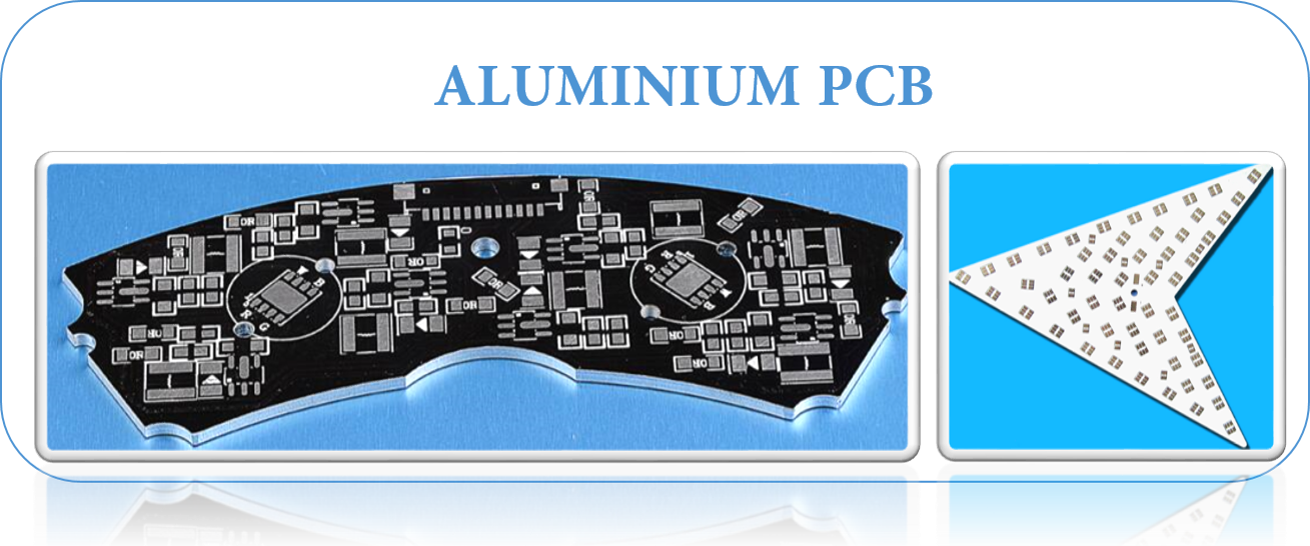
Using a specific PCB structure is usually a better solution. The commonly used solution is the metal core structure. With this solution, the printed circuit board is composed of aluminum plates bearing track patterns. Thermoelectric insulators are used between the track and the board so that heat can pass through the metal core structure, such as the Metal Core PCB .
While LED lighting is widely used, it is also necessary to eliminate the heat generated by LED lighting. Therefore, the development of LED lighting industry directly leads to the increase of PCB using aluminium core. At the same time, the market demand of LED PCB Board is also growing.
Copper may be used as an alternative.
For high-power LED, most customers use aluminum-based PCB; for low-power LED, standard Fr4 PCB is also available. Our PCB manufacturing specifications and construction of most types of metal-based Printed Circuit Boards.
Aluminum Based PCBs are a unique metal-based copper clad laminate. These types of Printed Circuit Boards have good thermal conductivity, electrical insulation and very solid machining performance.
They are also known as Aluminum Clad, Aluminum base, MCPCB (Metal Clad Printed Circuit Board), IMS (Insulated Metal Substrate), Thermally Conductive PCBs etc. Aluminum PCBs were developed in the 1970s, soon after which they`re applications increased dramatically. The first application was their use in Amplification Hybrid Integrated Circuits. Now they are being used at a large scale due to which it is necessary for us to have an idea of Aluminum PCBs and their importance.
ALUMINIUM PCB STRUCTURE:
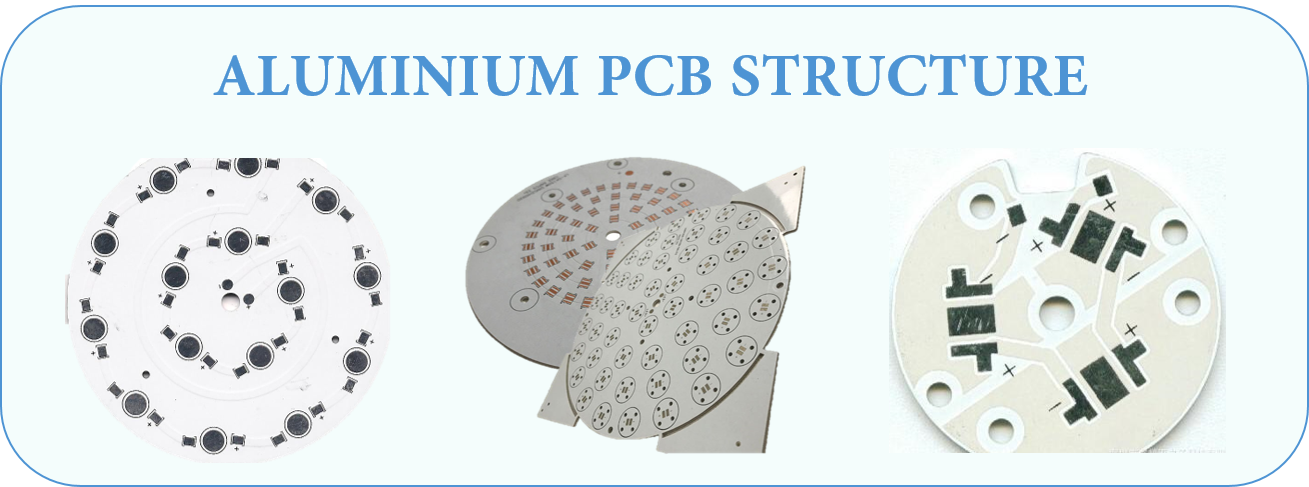
AluminumPCBs are actually quite similar to FR4 PCBs. The basic structure of Aluminum PCBs is four layered. It consists of a layer of copper foil, a dielectric layer, an aluminum base layer and aluminum base membrane.

- Copper Foil Layer: the copper layer used is relatively thicker than normal CCLs ( 1oz-10oz). A thicker layer of copper means a larger current carrying capacity.
- Dielectric Layer: the Dielectric layer is a thermally conductive layer and is around 50μm to 200μm thick. It had a low thermal resistance and it suitable for its application.
- Aluminum Base: The third layer isthe aluminum base which is made up of aluminum substrate. It has a high thermal conductivity.
- Aluminum Base Membrane Layer: Aluminum base membrane is selective. It has a protective role by keeping the aluminum surface safe from scraping and unwanted etching. It is of two types i.e. Lower than 120 degree or around 250 degrees (anti high temperature)
ALUMINUIM PCB ADVANTAGES
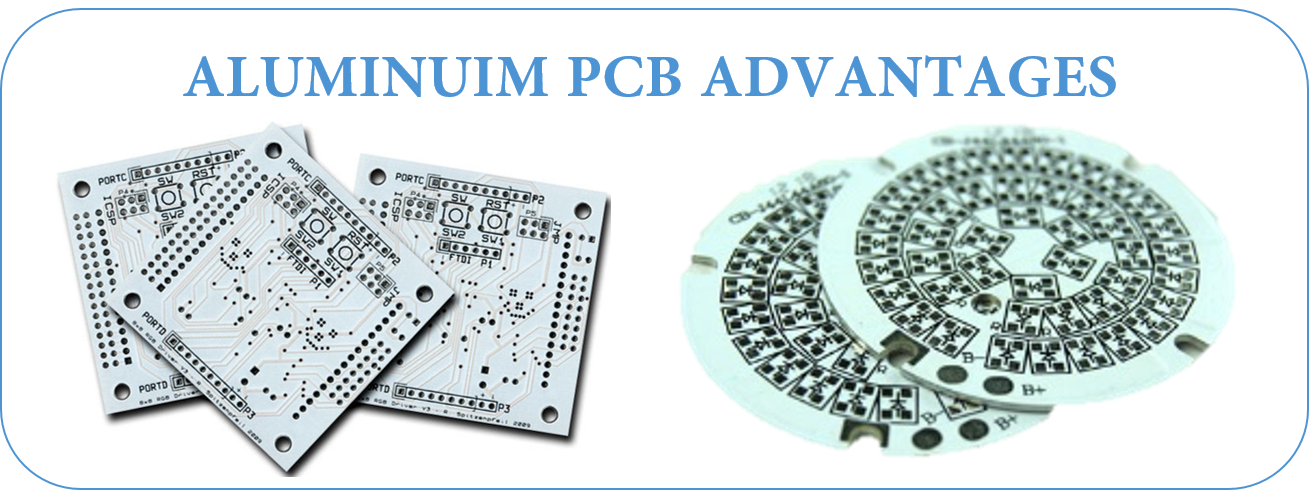
- Lower manufacturing and use costs: Aluminum is a metal that can be found in a variety of climates, so it is easy to mine and refine. Therefore, the costs of doing so are significantly lower than other metals. In turn, this means that manufacturing products with these metals are less expensive as well.Aluminum is a very common metal raw material, its mining and production are very convenient. Therefore, the cost of doing so is significantly lower than that of other metals. Conversely, this means that products made from these metals are also cheaper.
- More energy-saving and environmentally friendly: Aluminum is non-toxic and recyclable. Because it is easy to assemble, the use of aluminium also helps to save energy. For PCB vendors, the use of this metal helps to maintain the health of our planet.
- Better heat dissipation performance:Efficient heat dissipation is the greatest advantage of aluminium PCB. High temperature can cause serious damage to electronic equipment, so it is wise to use materials that can help heat dissipation. Aluminum can actually transfer heat from important components to minimize its harmful effects on circuit boards.
- Higher strength and durability: Aluminum provides strength and durability to a product that ceramic or fiberglass bases cannot. Aluminum is a sturdy base material that can reduce accidental breakage during manufacturing, handling, and everyday use.
- Lighter weight and better elasticity: Aluminum is widely recognized as a light metal. While increasing the heat dissipation performance of high power components, it also reduces the weight of the product itself, and increases the strength and elasticity. In addition, in the transportation of products, lighter weight also saves the transportation cost of products.
- Higher conductivity: Thermal conductance of dielectic used is 5 to 10 times higher than old epoxy glass.
- More effective and reliable: Thermal transfer is more efficient and reliable than regular PCB.
Aluminum PCB APPLICATIONS
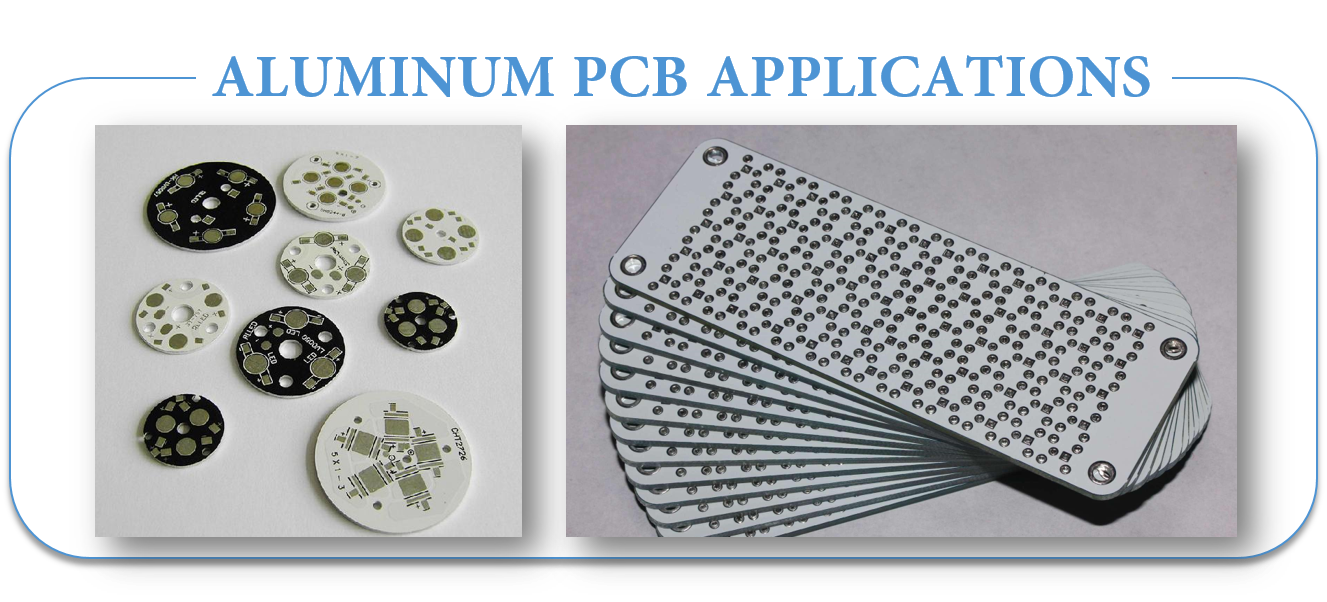
- Audio device: Input, output amplifier, balanced amplifier, audio amplifier, pre-amplifier,power amplifier.
- Power Supply: Switching regulator, DC / AC converter, SW regulator, etc.
- Communication electronic equipment: High-frequency amplifier, filtering appliances,transmitter circuit
- Office automation equipment: Motor drive, etc.
- Automobile: Electronic regulator, ignition, power supply controller, etc.
- Computer: CPU board, floppy disk drive, power supply devices, etc.
- Power Modules: Inverter, solid state relays, rectifier bridges.
- Lamps and lighting: As the advocated promotion of energy-saving lamps, a variety of colorful energy-saving LED lights are well received by the market, and aluminum pcb used in LED lights also begin large-scale applications.
TYPES OF ALUMINUM PCB
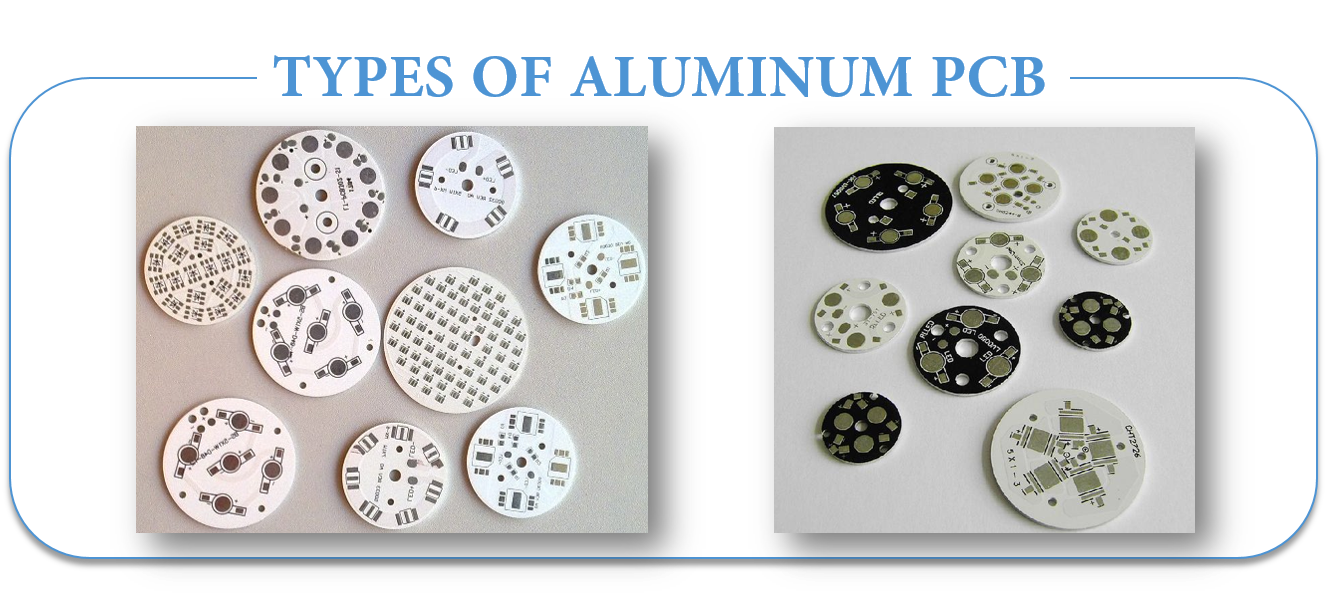
-
Flexible Aluminum PCB
Firstly, Flexible aluminium PCB is a new flexible dielectric developed in the development of aluminium products. It is also a kind of flexible circuit board. Because of the combination of polyimide resin and ceramic filter, it has high flexibility, thermal efficiency and excellent electrical insulation. When used in aluminium PCB products, the expensive cables and connectors no longer need to be used.
Flexible circuit boards have unparalleled flexibility, so flexible aluminum PCB can be arbitrarily folded, twisted or formed in any other desired form. However, it should be noted that once a specific shape is formed, it can no longer be changed like other conventional flexible circuit boards. Or deform.
-
Hybrid Aluminum PCB
In hybrid aluminum construction, non-thermal material is processed and refined separately before it is applied to the thermal materials with aluminum base.
The most common practice is developing 2 layer or 4 layer structure which comprises of FR4 material.
A non thermal material that is bonded with thermal material and aluminum base provides rigidity and helps in the dissipation of heat.
This non thermal bonding is preferred over using all thermal materials because it features less cost and encompasses efficient thermal conductance over regular FR4 products.
No heat sinks or assembly steps are required for the development of this product.
Through hole components can be easily adjusted using component windows on the aluminum base.
This helps in passing the cables and connectors through substrate. Also the seal created by solder fillet eliminates the need of costly adopters.
-
Multilayer Aluminum PCB
Multilayer Aluminum PCBs are very common in power supply products and come with multiple layers of thermally conductive dielectrics.
These materials are very useful when they are combined with one or more layer of circuitry in which thermally conductive dielectric is buried between the layers with the help of blind vias which also act as a signal or thermal vias.
Single layer construction of these designs is not very effective, however, when they come with more complex designs they provide an ideal solution for many applications involving heat dissipation.
-
Through Hole Aluminum PCB
When it comes to most complex constructions, a single layer of aluminum is back-filled and pre-drilled with before applying lamination, forming a Core of a multilayer constructions.
Thermal bonding materials are then used to laminate the thermal materials on both sides of the aluminum.
Once lamination is done, drilling is applied on the assembly.
In order to maintain proper electrical insulation, the plated through holes created as the result of drilling must pass through aluminum clearances.
ALUMINUM PCB PERFORMANCE
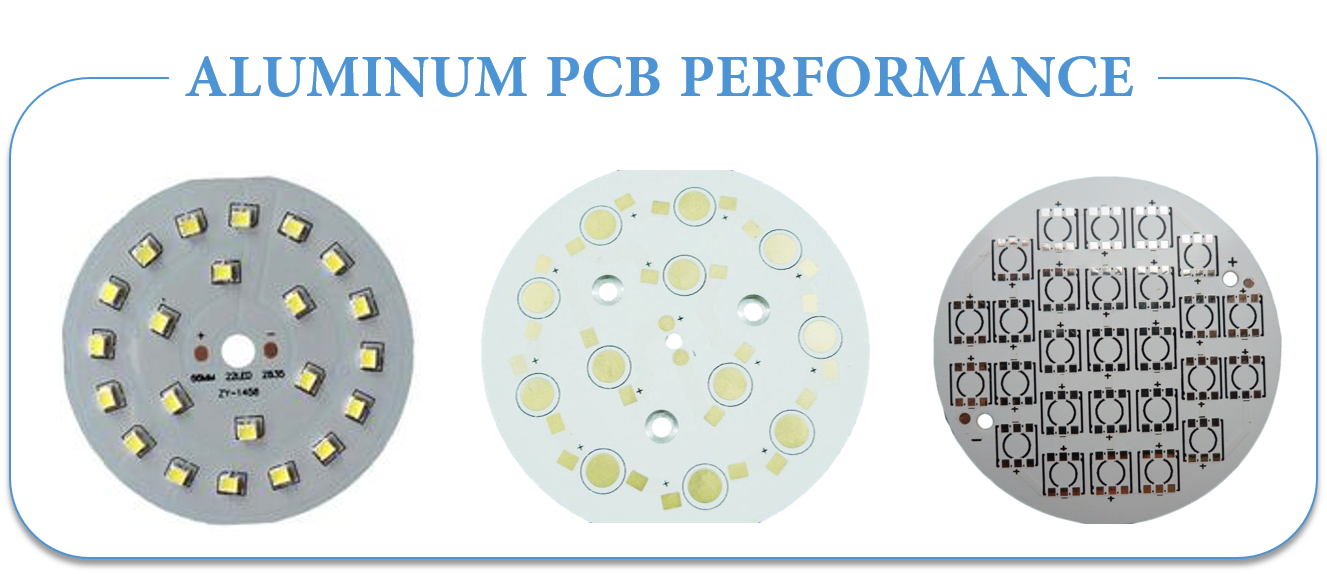
- Better heat dissipation and conductivity: Compared with ordinary FR4 PCB, aluminium PCB has excellent heat dissipation performance. For example, Fr4 PCB with a thickness of 1.5mm will have a thermal resistance of 20-22 degrees per watt, while aluminium PCB with a thickness of 1.5mm will have a thermal resistance of 1-2 degrees per watt.
- There is no serious problem of thermal expansion or contraction.: each substance has its own coefficient of thermal expansion. The CTE of aluminum (22ppm/C) and copper(18ppm/C)is quite close. Since aluminum PCBs work well in terms of Thermal dissipation they do not have severe expansion or contraction issues. They work excellently and are durable and reliable.
- Dimensional Stability: aluminum PCBs show dimensional stability and stable size. For example, when they are heated from 30-140 degrees, their size only had a change by 2.5%-3.0%.
- Others: Aluminum PCBs can be used in power device surface mount technology. They are effective for use in circuit design because of their performance in terms of thermal expansion of circuit design. They help to prolong products shelf life and product power density. They are also extremely reliable. They can help to shrink the overall volume of the product and is also a cheaper option. They show electromagnetic shielding and high dielectric strength.
CLASSIFICATION OF ALUMINUM PCB
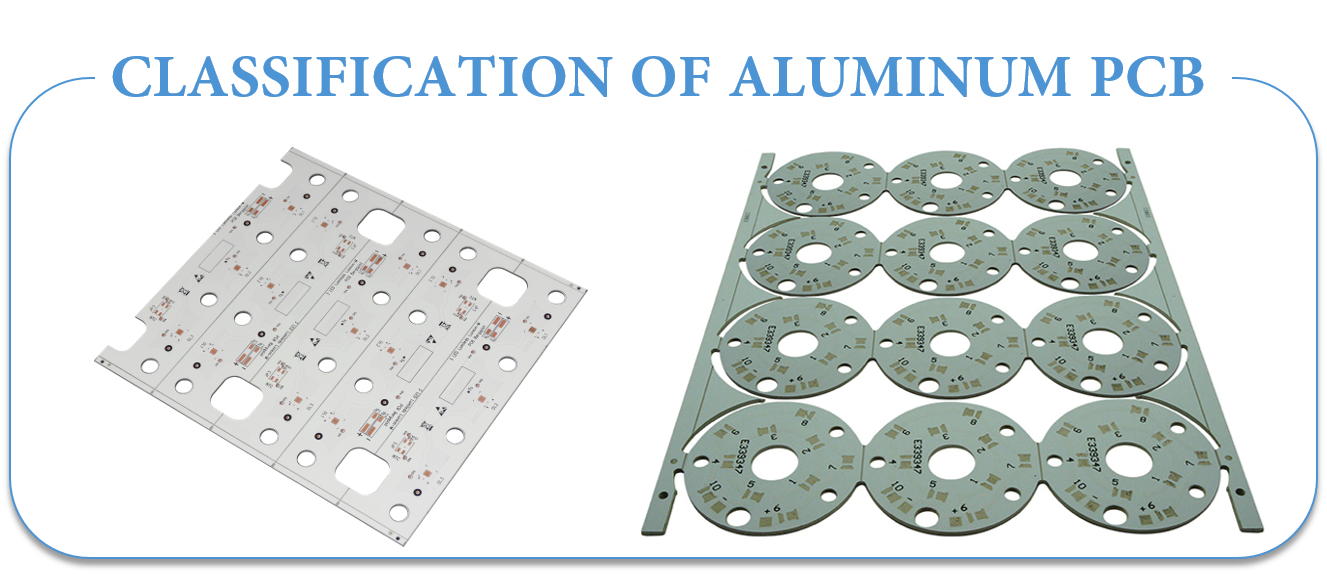
- Universal Aluminum PCB: the dielectric layer used here is made up of epoxy glass fiber pre-preg.
- High Thermal-Conductive Aluminum PCB: the dielectric layer is made up of epoxy resin. The resin used must have high thermal conductivity.
- High-frequency Aluminum PCB: the dielectric layer is composed of polyolefin or polyimide resin glass fiber pre-preg.
MANUFACTURING DIFFICULTIES OF ALUMINUM PCB
The manufacturing process for nearly all aluminum PCBs is essentially the same. Here we will discuss the major manufacturing processes, the difficulties and their solutions.
- Copper Etching: the copper foil used in Aluminum PCBs is comparatively thicker. If the copper foil is over 3oz however, the etching requires width compensation. If it is not according to the demand of the design, the trace width will be out of tolerance after etching. Therefore the trace width compensation should be designed accurately. The etching factors need to be controlled during manufacturing process.
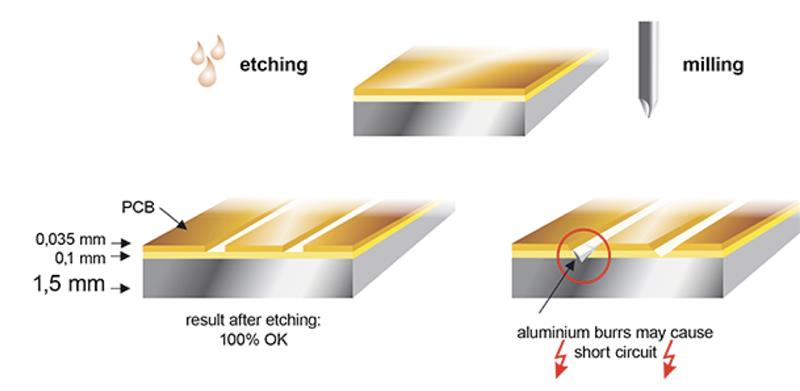
- Solder Mask Printing: due to the thick copper foil there is a difficulty in solder mask printing of aluminum PCB. This is because if the trace copper is too thick then the image etched will have a large difference between trace surface and base board and solder mask printing will be difficult. Therefore, the two-time solder mask printing is used. The solder mask oil used should be of good quality and in some cases the resin filling is done first and then solder mask.
- Mechanical Manufacturing: the mechanical manufacturing process involves mechanical drilling, molding and v-scoring etc. which Is left on internal via. This tends to reduce electrical strength. Therefore, the electric milling and professional milling cutter should be utilized for low-volume manufacturing of products. The drilling parameters should be adjusted to prevent burr from generating. This will help your mechanical manufacturing.
Key Requirements When Selecting an Aluminum PCB Manufacturer
For the most part, all PCB manufacturing follows the same production process regardless of where they are made. The only true differences in suppliers is the level of automation in their process, the newest technology and equipment, and having specific equipment designed to focus on certain types of end products.
For aluminum PCBs, there are several key items that a PCB manufacturer needs to consider if they are going to be able to effectively produce aluminum PCBs in any quantity, including:
- Dedicated Imaging Equipment
Many of our aluminum backed PCBs go into LED applications that are much longer than the standard 18" x 24" or 20" x 24" production panels used in traditional PCB manufacturing. To be able to accurately register and economically produce these parts, a manufacturer must have either a custom piece of 60" wide UV light imaging equipment or a setup capable of screen printing (at one time) an image and then UV curing through an oven.
The old manufacturing process of screen printing half the image and then trying to hand register the first image while screen print the second half is much less effective.
- Specialized Scoring Equipment
The more common equipment that can V score through traditional FR-4 materials is not suited to manage aluminum PCBs. To get the lowest cost possible, we need to get the best yield possible, which means we need to be able to place these parts as close as possible to each other on the production panel. Without V scoring, you must mechanically rout the parts out, which could result in up to 20% loss of your yield, subsequently increasing cost.
Our engineering team has many years of experience helping our customers design arrays that are the most cost effective for them to depanelize.
- Greater Than 40-ton Punch Presses
For aluminum PCBs that are round or have unique features – (slots, large holes, cutouts, etc.) – you will want a manufacturer that can punch out these features. Trying to mechanically rout aluminum PCBs is a very costly way to get these features done in a production environment.
- In-Line Hi-Pot Test
A unique requirement of aluminum PCB is that customers want to know that the product they are getting has passed a hi-pot test. While most PCB manufacturers can do this, it is usually a separate process in a lab that is not located in electrical testing. Epec`s electrical test set up includes a hi-pot test, which dramatically reduces cost for the customer.
The following table presents some of our Aluminum Core materials:
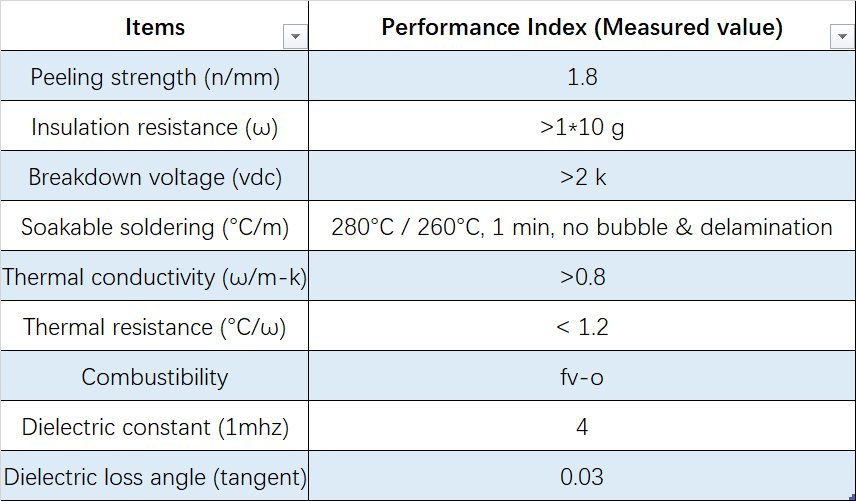
Check our Aluminum core PCB manufacturing capabilities in the following table:

DESIGN GUIDELINES FOR ALUMINUM PCB
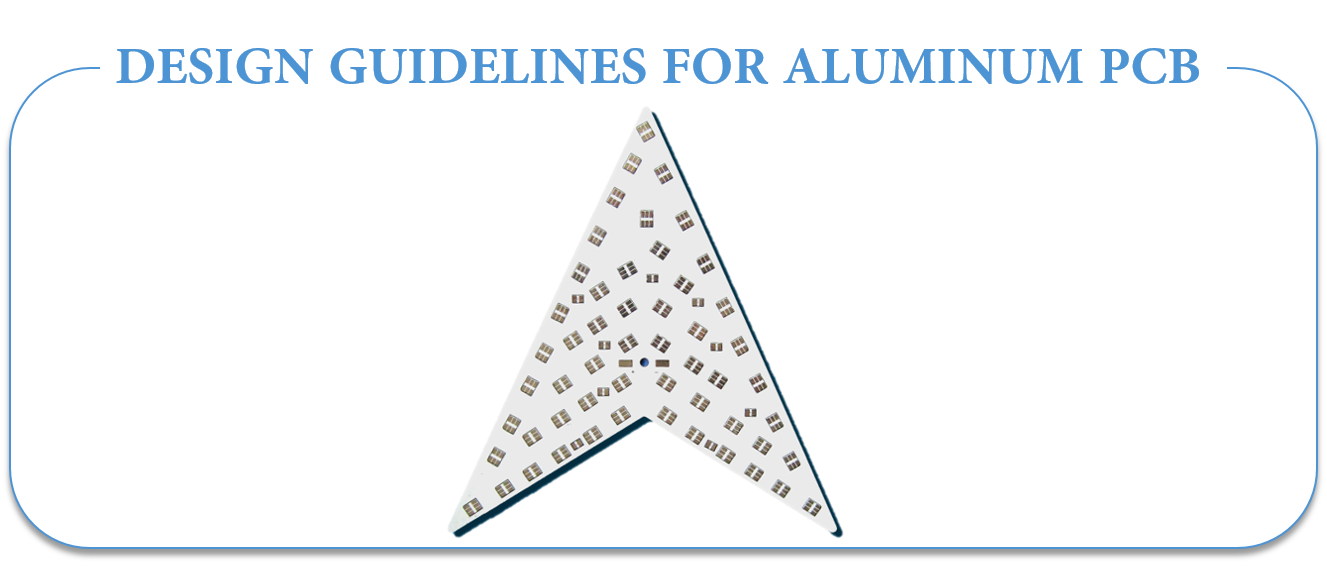
The task of aluminum core circuit board is to dissipate the heat generated by power components. Therefore, we recommend installing pure power components in this part of the circuit. The control unit shall be installed on a separate standard PCB.
Drilling distances and diameters
In case of double-sided aluminium-core circuits, the aluminium core must be insulated against throughplating. This is done using an excess of resin when press-moulding the aluminium core with prepregs and copper or by plugging. To this end, the aluminium core must be pre-drilled.
The smallest drilling diameter in the aluminium core is 1,0 mm, the smallest final diameter in the PCB is 0,3 mm. So that the drills are not damaged in these close-set drill holes, a minimum spacing of 1,2 mm is required. This is generally the knock-out criteria for a densely-packed control unit.
Variants of aluminium core circuits
-
Single-sided PCBs on aluminium carriers
Normally, this variant only has drill holes for fastenings.
-
Multilayer PCBs with aluminium core
Copper foils are laminated onto both sides of an aluminium core using prepreg. The PCB can be through-plated. This means that it is also possible to produce multilayers with a 0,5 mm aluminium core.
-
PCBs on metal heat-conducting sheets
Completed PCBs are press-moulded to an aluminium carrier using a prepreg. Benefit: Multilayers can also be used (only single-sided SMD). Partial aluminium carriers are possible. Disadvantage: Poor heat dissipation, as the heat has to be dissipated through the entire PCB.
-
Aluminium-flex
One further possibility is a rigid- Flex PCB structure, where the aluminium carrier works as the rigid area of the PCB. This means that it is also possible, for example, to connect a control unit as a plug connector over the exposed flex area.
BASICS OF HEAT TRANSFER
At a basic level, a discussion about heat transfer includes two topics: temperature and heat flow. Temperature represents the level of thermal energy that`s available, while heat flow represents thermal energy movement from one place to another.
Microscopically, thermal energy is directly related to a molecule`s kinetic energy. The greater the temperature of a material, the greater the thermal agitation of its molecules. It`s normal for areas that contain a lot of kinetic energy to pass it along to areas with less kinetic energy.
There are some material properties that effectively modulate heat that`s transferred between two areas at different temperatures. These include thermal conductivities, material densities, fluid velocities and fluid viscosities. Together, these properties make resolving many heat transfer problems pretty complicated.
THE MECHANISMS OF HEAT TRANSFER
Heat transfer mechanisms can be grouped into three broad categories:
- Conduction. Areas that have more molecular kinetic energy will send their thermal energy to areas that have less molecular energy. This occurs through a direct collision of molecules, known as conduction. In metals, some of the energy transported from one area to another is also carried by conduction-band electrons.
- Convection. When heat is generated in an electronic device, it`s transported via conduction to an are where it is then transferred to a fluid. That process is convection, and the fluid can take the form of a gas such as air or conventional water.
- Radiation. All materials give off thermal energy in amounts that are determined by temperature. When the temperatures are uniform, the radiation flux is in in equilibrium between objects, and there is no exchange of thermal energy. This balance changes when temperatures vary and thermal energy is transported from areas of higher temperatures to those of lower temperature.
HELP RESOURCES
Quick Turn Aluminum PCB
Aluminium PCB Board for LED
Aluminium Base Metal Core PCB
Aluminum PCBs vs. Standard PCBs
Using aluminium in Flexible Circuits Board
Things You Need To Know About Aluminum PCBs
Aluminum PCB
Aluminum PCB,Aluminum PCB Led,Aluminum Core PCB,Aluminum Circuit Board
JingHongYi PCB (HK) Co., Limited , https://www.pcbjhy.com